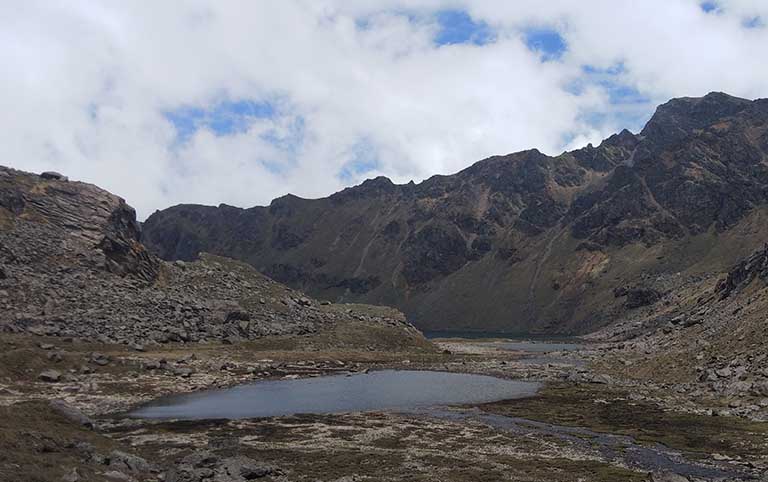The Wood Snipe Gallinago nemoricola is listed as globally Vulnerable in the IUCN Red List (BirdLife International 2017) and National Red List of Nepal (Inskipp et al. 2016). Within Nepal, the species is rare and sparsely distributed, breeding locally in April–June in alpine meadows and marshes with scattered low bushes, or in dwarf scrub in barren, boulder-strewn areas, between about 3,000–5,000 m asl. In Nepal (and elsewhere), information concerning Wood Snipes is sparse with only a few records in the post-1990s. It may breed in Langtang, Sagarmatha, Makalu Barun and Shey-Phoksundo National Parks, and Kanchenjunga and Annapurna Conservation Areas where recorded in small numbers in the breeding season. A Wood Snipe focused survey has only once been conducted before in Nepal, in 2007, with seven individuals recorded in the Goshainkunda and Associated Lakes (GAL) area (within Langtang National Park), a Ramsar site of international importance. Uncontrolled livestock grazing resulting in habitat degradation is considered the main threat to its breeding grounds, along with disturbance and pollution during the festive season (the area being of religious importance to Hindus and Buddhists who visit in large numbers in summer) contributing to the reduced breeding success (Khatiwada et al. 2010). Thus, to enhance the knowledge of Wood Snipe ecology and to encourage conservation initiatives, in 2019 a follow-up survey was conducted in GAL by Small Mammals Conservation and Research Foundation financially supported Oriental Bird Club and Wader Quest in collaboration with Bird Conservation Nepal.
Till now, 1,000 copies of a Wood Snipe conservation poster were produced, distributed and displayed in park headquarters, lodges and tea shops along the Goshainkunda trekking route. Additionally, 500 copies were distributed to Bird Conservation Nepal (BCN) for promotional use amongst bird tour guides and university graduates. The poster was launched on World Environment Day (5 June 2019) by the Chief Guest at the event, Litterateur century personality, and culture expert Mr. Satya Mohan Joshi in front of over 2,000 attendees. The Day was celebrated at Jawalakhel Stadium opposite the Central Zoo (CZ). This ‘mass awareness’ event was led by National Trust for Nature Conservation together with Lalitpur Metropolitan, International Union for Conservation of Nature Nepal, World Wildlife Fund Nepal.
During our survey, calling Wood Snipe were heard in the same areas on each of the three survey days: 2 calls from either side of a marshy area in lakes east of Goshainkunda; 1 call at Agni Kunda; and 2 calls at Naukunda. Thus at least five snipe were considered holding territories in the GAL survey area. However as there were a total of 15 responses (five each over three survey days), this might possibly relate to more birds. The number may also, of course, be more as some may not have responded to playback or birds present may have been beyond the 300 m radius within which birds could be heard by the surveyor.
School awareness programs were conducted in the lower and secondary school at Thulo Saprobesi. A thirty-minute class awareness program was held to explain the conservation motives as well as sharing knowledge on the ecology of Wood Snipe, its habitat, major challenges and individual responsibility for conservation. Community awareness programs were conducted in the Goshainkunda area targeting local herders, hotel staff, trekkers, porters, and forest staff. Emphasis was laid on the effects of anthropogenic threats, our role, and responsibility towards the species.
Posted on July 29, 2019

